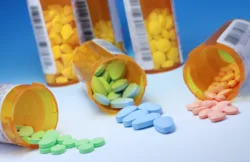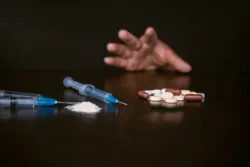Gateway Drugs? Do They Really Exist?

To many, the concept of “gateway drugs” might seem dated, or like a relic of the DARE programs of their school days.
However, the term has remained a part of the popular lexicon surrounding addiction and drug and alcohol use ever since its introduction in the 1980s. The phrase was a reflection of an idea taking a firm hold in the research community: addiction developed through different stages over time.
Evidence to Support Gateway Drugs Still Exist
So, what are gateway drugs? Gateway drugs are mild or even legal substances, such as nicotine or alcohol, that can prime a user to try harder drugs, such as heroin or cocaine. Although many critics of the concept of gateway drugs consider current scientific evidence to be lacking, anecdotal evidence of the phenomenon persists. Researchers also point to persistent trends among addicted people that support the theory of gateway drugs.
The concept of cross-sensitization also supports the idea that certain drugs can lead an individual to use more addictive or dangerous substances. Cross-sensitization suggests that the effects of one drug may enhance a person’s experience with a second, different drug, explaining why individuals who use alcohol or nicotine may be more susceptible to using harder drugs after repeated exposures to more mild substances.
Skeptics of the idea of gateway drugs point to the multitude of other factors that can lead to addiction, such as a family history of substance use, untreated mental health issues like depression or anxiety, an unfulfilling social life, a history of domestic abuse, or a negative home environment.
What Recent Research Says
A recent study funded by the and published in Science Advances demonstrated that rats who consumed alcohol over a period of time were much more likely to continue pressing a lever, giving them access to cocaine (even when pushing the level administered an electric shock) than those rats who hadn’t been primed with alcohol. Rats that consumed alcohol also experienced chemical changes in their brains that made them more vulnerable to cocaine dependency and addiction.
Rats share many neural similarities with humans, making the results of this study something to consider in the debate over the existence of gateway drugs.
Overall, it is possible for an individual to use alcohol or nicotine without trying harder substances like heroin or cocaine. Many people drink or smoke recreationally without becoming addicted to drugs. However, it’s important to monitor the use of gateway drugs, particularly in teens.
Here are findings from DrugRehab.com and the Center on Addiction at Substance Abuse at Columbia regarding gateway drugs in teens and adults:
- Teens who use gateway drugs are 266 times more likely to become addicted to cocaine than those who don’t.
- Children who drink are 50 times more likely to use cocaine than nondrinkers.
- Adults who drank during their childhood are six times more likely to use cocaine regularly
- Nearly all cocaine users tried marijuana, cigarettes, or alcohol before cocaine; nearly 90 percent had tried all three substances
Outpatient treatment may be appropriate for adults or teens who are using gateway drugs. Detoxification and inpatient treatment may be appropriate for adults or teens who have begun using harder substances, like cocaine or heroin. For more information on receiving these services from Pyramid Healthcare, call (888) 694-9996 today.
Written by Rebecca Jones, Marketing Specialist
To many, the concept of “gateway drugs” might seem dated, or like a relic of the DARE programs of their school days.
However, the term has remained a part of the popular lexicon surrounding addiction and drug and alcohol use ever since its introduction in the 1980s. The phrase was a reflection of an idea taking a firm hold in the research community: addiction developed through different stages over time.
Evidence to Support Gateway Drugs Still Exist
So, what are gateway drugs? Gateway drugs are mild or even legal substances, such as nicotine or alcohol, that can prime a user to try harder drugs, such as heroin or cocaine. Although many critics of the concept of gateway drugs consider current scientific evidence to be lacking, anecdotal evidence of the phenomenon persists. Researchers also point to persistent trends among addicted people that support the theory of gateway drugs.
The concept of cross-sensitization also supports the idea that certain drugs can lead an individual to use more addictive or dangerous substances. Cross-sensitization suggests that the effects of one drug may enhance a person’s experience with a second, different drug, explaining why individuals who use alcohol or nicotine may be more susceptible to using harder drugs after repeated exposures to more mild substances.
Skeptics of the idea of gateway drugs point to the multitude of other factors that can lead to addiction, such as a family history of substance use, untreated mental health issues like depression or anxiety, an unfulfilling social life, a history of domestic abuse, or a negative home environment.
What Recent Research Says
A recent study funded by the and published in Science Advances demonstrated that rats who consumed alcohol over a period of time were much more likely to continue pressing a lever, giving them access to cocaine (even when pushing the level administered an electric shock) than those rats who hadn’t been primed with alcohol. Rats that consumed alcohol also experienced chemical changes in their brains that made them more vulnerable to cocaine dependency and addiction.
Rats share many neural similarities with humans, making the results of this study something to consider in the debate over the existence of gateway drugs.
Overall, it is possible for an individual to use alcohol or nicotine without trying harder substances like heroin or cocaine. Many people drink or smoke recreationally without becoming addicted to drugs. However, it’s important to monitor the use of gateway drugs, particularly in teens.
Here are findings from DrugRehab.com and the Center on Addiction at Substance Abuse at Columbia regarding gateway drugs in teens and adults:
- Teens who use gateway drugs are 266 times more likely to become addicted to cocaine than those who don’t.
- Children who drink are 50 times more likely to use cocaine than nondrinkers.
- Adults who drank during their childhood are six times more likely to use cocaine regularly
- Nearly all cocaine users tried marijuana, cigarettes, or alcohol before cocaine; nearly 90 percent had tried all three substances
Outpatient treatment may be appropriate for adults or teens who are using gateway drugs. Detoxification and inpatient treatment may be appropriate for adults or teens who have begun using harder substances, like cocaine or heroin. For more information on receiving these services from Pyramid Healthcare, call (888) 694-9996 today.
Written by Rebecca Jones, Marketing Specialist







